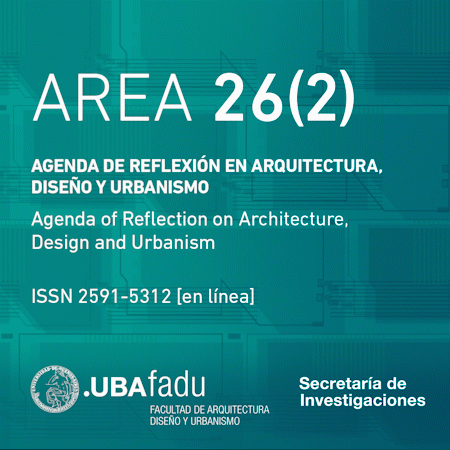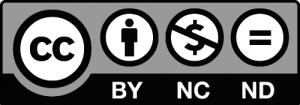
MAY 2020 / OCTOBER 2020
Director: Dra. Arq. Rita Laura Molinos
Editor: Dra. María Ledesma
Coeditor: DG. Miguel A. Santángelo
Technical editor: DG. Emiliano M. Eseiza
© The contents and metadata of this magazine are licensed under Open Access CC BY-NC-ND 2.5 AR
DNDA registration of the digital edition in process

Contents
General researh topics
Urbanism and gender. Women within the urbanistic canon: from the positive exception to systematic exclusion
Octavio Fernández Álvarez
Abstract
The objective of this paper is to offer some interpretations to analyse the canon of urbanism from a gender perspective. The discipline does not escape the general trend of inequality in access to the professional field, forming and sustaining exclusion mechanisms based on a system of excuses. Although certain characteristics of urbanism made it more permeable to the participation of women, they continue to be separated from recognition, although with some differences. We will take as an example the professional careers of Jane Jacobs and Denise Scott Brown. Then, we will analyse both cases based on some concepts coined from gender studies, which will allow us to understand how their trajectories are framed in the discourse or disciplinary canon. Finally, this analysis will serve to raise some questions about inequalities in the field of urbanism.
Laguna de Chascomús (the Chascomús lagoon) in five times. Confluences and disputes between landscape, environment and urbanization
Mariana Giusti, Gabriel La Valle y Anahí Nieva
Abstract
The present work focuses in the Buenos Aires province interior, in Chascomús and its territory located in the depressed basin of El Salado river. It focuses on analysing and explaining, throughout its history, the relationships that have been established between urban, rural and natural environment, focusing on the role of the Chascomús Lagoon in its physical-spatial conformation. It seeks to recognize how, throughout different historical, economic and social contexts, and according to different perspectives and tensions, the wetland and lagoon systems have been a fundamental and distinctive element in which landscape, environment and urbanization converge and are disputed.
Topological stereotomy as an innovative resource for sustainable design
Javier Alejandro Bazoberri
Abstract
This work explores the potential of the system of concepts, figures and elements of the topological stereotomy for the development of sustainable products in relation to timeless design or classic design. The systematic study of regional cases shows coincidences between topological stereotomy and the basic requirements of the problem addressed. In turn, this topological scheme defines restrictions that lead to a more efficient sustainable project development.
Estrangement. The bodily experience within the altered space of the former Marconetti Mill
Lucas Javier Bizzotto
Abstract
With experience as a unifying notion and seeking to delve into the logics of experience within a singular architectural site, the Marconetti Mill is studied; a building located in the Port of Santa Fe (Argentina), where the Municipal Lyceum now operates. This work’s hypothesis is that the building’s nature as an altered architectural space gives way to a bodily experience of estrangement. In order to support this hypothesis, a phenomenological explanation of perceptive experience and the concept of estrangement are both here developed. Thereupon, it’s shown how this concrete case of the Municipal Lyceum, through its materiality, spatial dimensions, memory and physical context, among other variables, produces such estrangement.
The Zanjón water channel as structuring element of the agro-industrial production in Mendoza. The cases of Luján de Cuyo and Godoy Cruz
Ana María Villalobos y Pablo Bianchi
Abstract
This project enrols in the framework of investigations related with industrial heritage, most precisely with productive heritage located in a territory and landscape characterized by an extreme arid climate. As a practice sustained over time, it shows shapes and technics of water use which result in a rich variety of examples of architecture and engineering for agricultural and industrial use, that testify a productive activity in the territory. This creates a group of tangible and immaterial goods of a meaningful value which sustain identifying features of the oasis in Mendoza.
Alternative financing tools for housing. Public-private associations in the city of Rosario, Argentina
Cintia Ariana Barenboim
Abstract
The city of Rosario, Santa Fe, Argentina, has a great track record in the country in public-private associations (PPA), obtaining the necessary financial resources for housing and infrastructure. The municipality assumes new responsibilities for preparing and managing projects, introducing instruments (special plans, urban agreements), while the private sector makes the investment and executes public or private works, agreeing on financing modalities.
In this context, it is interesting to analyse PPAs as an alternative financing tool for housing, in terms of its content and implementation in the city. In addition, critical points and opportunities can be detected and may contribute to future policies.
Behavioral intervention in university students through digital tools
Carlos García Arano y Marcos Evencio Verdejo Manzano
Abstract
This article presents the results of a study about the use of a virtual tool for tracking grades in university students, which favoured their decision making and self-regulation processes and delivery of work and activities during two different semesters in which the intervention was implemented. This research was designed based on the methodology known as design thinking, blended with the methods and processes of the emerging discipline known as Learning Analytics, as well as the concept of loss aversion of the Prospective Theory of Behavioural Economics.
The results were analysed by statistical methods that reflects a significant difference in the variables considered for this intervention, which pointed to the attendance to class, delivery of works in time and proper way, as well as the qualitative considerations of the use of an immediate follow-up tool for their grades. This document points to the possibilities of using technology to improve the self-regulation process in students and the possibilities of generating new low-cost proposals for interventions, which favour their organization and learning process, and the teacher’s monitoring for large groups.
Supermodels
Santiago Miret y Melisa Brieva
Abstract
The article proposes, first, through the conceptual development of the terms of type, model and organization and, then, by the presentation of a series of emerging projects of the supermodel Précis des Leçons d’Architecture: Données a l’Ecole Impériale Polytechnique from Jean-Nicolas-Louis Durand, an approach to the notion of supermodel in Architecture as the possibility of, on the one hand, learning from the disciplinary lineages considered canonical as an inexhaustible source of knowledge and, on the other, the opportunity to build projects that contain a multiplicity of projects as original and vital as the original model from which they emerge.
The processes of socio-spatial disputes within urban systems as a generating principle of structure
Mariano A. Ferretti
Abstract
The material organization of contemporary urban space is undoubtedly the result of certain disputes over the construction of meaning. In them, the negotiation phenomena that characterize the actions undertaken by the systems that intervene to locate their interests and whose tensions produce imbalances in urban functions are revealed, thus conditioning the behaviors of the individuals that –recursively– come into play with consequences in their living conditions such as: strong distortions in the values and uses of the land, extensive consumption of the territory and high degrees of privatization of collective spaces, among others. With the aim of characterizing the internal displacements that occur in the object of study (urban systems), a hermeneutic is proposed that allows interpreting –from the conceptualization and abstraction of the involvement– not only the way of functioning that these acquire bidding but also substantiate the uniqueness of its critical moments.
Modeling socio-spatial representation. Towards a model for the analysis of spatial-cultural identity
Pablo García de Paredes
Abstract
Social space is the transdisciplinary real-life space where architecture exists. In this article I will propose a new modelling of the epistemological processes that generate spatial identity, based on multidisciplinary theory. The aim of the model is to ponder the effect of urban space on the creation of representations that city dwellers use to explain social and urban dynamics. The model was applied using a rigorous experiment with virtual reality in Panama City. Results show that the daily urban itineraries of the respondents affect the functional reconstruction of the city, creating systems of representation of the social and urban dynamics that are characteristic of specific social groups. The evidence proves the relevance of the model as a transdisciplinary analytical tool for Architecture, Urbanism, Urban Geography, and Urban Sociology.
Architecture with reused objects. Technological reused and transformation processes of disused objects
Magdalena Molina, Eliana Cangelli y Mariana Gatani
Abstract
The environmental problem of solid waste is latent and is part of the present not only locally but also internationally. The rate of waste generation forecast worldwide will be 44% higher by the 2025. Faced with this environmental problem, organizations and architects from different parts of the world have begun a trial / experimentation path with solid waste in order to grant a second life to discarded products and / or materials. The aim of the article is to analyse various case studies that under simple processes of reuse and transformation reinsert solid waste into new cycles. In particular, they are reintegrated in construction cycles giving rise to an architecture with a sustainable approach, based on the three pillars of sustainability: economic, social and environmental. The research methodology implemented was based on collecting the case studies. Emphasis was placed on reuse and transformation processes as well as the resulting architecture. The discussion of the ongoing research was based on the analysis of the variables location, client, residues and built components. In conclusion, the article states that despite being built under the cradle-to-cradle concept, in the cases analysed it would be necessary to evaluate their technical performance, their environmental performance, and their environmental, economic and social impact.
Review
The importance of shape in architectural acoustics
Juan Manuel Cañonero
